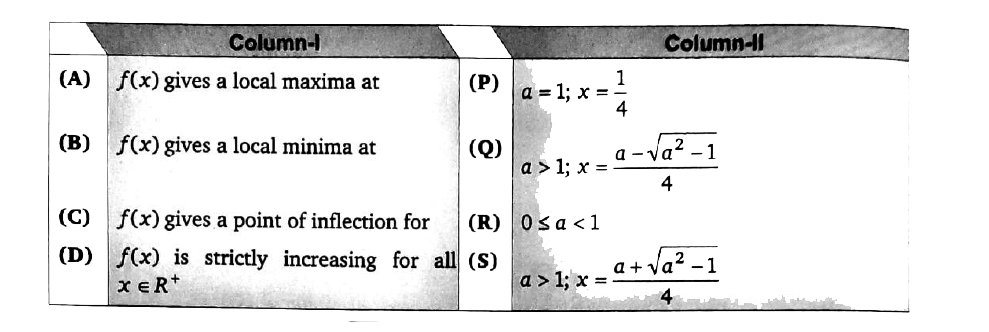Consider the function
Area enclosed by and the coordinate axes is
None of these
The correct Answer is:A
To find the area enclosed by the function f(x)=x3−8x2+20x−13 and the coordinate axes, we will follow these steps:
Step 1: Find the roots of the function
To determine the area enclosed by the curve and the axes, we first need to find the points where the function intersects the x-axis. This is done by solving the equation f(x)=0.
We can start by checking for rational roots using the Rational Root Theorem. Testing x=1:
f(1)=13−8(12)+20(1)−13=1−8+20−13=0
Since f(1)=0, x=1 is a root. We can factor f(x) as (x−1)g(x).
Step 2: Perform polynomial long division
Now, we will divide f(x) by (x−1) to find g(x).
Using synthetic division or polynomial long division, we divide x3−8x2+20x−13 by x−1:
1. Divide the leading term: x3÷x=x2
2. Multiply: x2(x−1)=x3−x2
3. Subtract: (−8x2+x2)=−7x2
4. Bring down the next term: −7x2+20x
5. Divide: −7x2÷x=−7x
6. Multiply: −7x(x−1)=−7x2+7x
7. Subtract: (20x−7x)=13x
8. Bring down: 13x−13
9. Divide: 13x÷x=13
10. Multiply: 13(x−1)=13x−13
11. Subtract: 0
Thus, we have:
f(x)=(x−1)(x2−7x+13)
Step 3: Solve the quadratic equation
Next, we need to find the roots of x2−7x+13=0 using the quadratic formula:
x=−b±√b2−4ac2a=7±√(−7)2−4(1)(13)2(1)=7±√49−522=7±√−32
Since the discriminant is negative, x2−7x+13 has no real roots. Therefore, the only real root is x=1.
Step 4: Determine the area under the curve
To find the area enclosed by the curve and the axes, we need to evaluate the integral from x=0 to x=1:
Area=∫10|f(x)|dx
Since f(x) is negative between x=0 and x=1, we will take the absolute value:
Area=−∫10(x3−8x2+20x−13)dx
Step 5: Calculate the integral
Calculating the integral:
∫(x3−8x2+20x−13)dx=x44−8x33+10x2−13x
Evaluating from 0 to 1:
=(144−8(13)3+10(12)−13(1))−(0)
Calculating this gives:
=(14−83+10−13)
Finding a common denominator (12):
=(312−3212+12012−15612)=(3−32+120−15612)=−6512
Taking the absolute value:
Area=6512
Final Answer
The area enclosed by y=f(x) and the coordinate axes is:
6512 square units
To determine the area enclosed by the curve and the axes, we first need to find the points where the function intersects the x-axis. This is done by solving the equation f(x)=0.
Now, we will divide f(x) by (x−1) to find g(x).
2. Multiply: x2(x−1)=x3−x2
3. Subtract: (−8x2+x2)=−7x2
4. Bring down the next term: −7x2+20x
5. Divide: −7x2÷x=−7x
6. Multiply: −7x(x−1)=−7x2+7x
7. Subtract: (20x−7x)=13x
8. Bring down: 13x−13
9. Divide: 13x÷x=13
10. Multiply: 13(x−1)=13x−13
11. Subtract: 0
Next, we need to find the roots of x2−7x+13=0 using the quadratic formula:
To find the area enclosed by the curve and the axes, we need to evaluate the integral from x=0 to x=1:
Calculating the integral:
The area enclosed by y=f(x) and the coordinate axes is:
Topper's Solved these Questions
- BOOK - ARIHANT MATHS ENGLISHCHAPTER - AREA OF BOUNDED REGIONSEXERCISE - Exercise For Session 110videos
AREA OF BOUNDED REGIONS
- BOOK - ARIHANT MATHS ENGLISHCHAPTER - AREA OF BOUNDED REGIONSEXERCISE - Exercise For Session 219videos
AREA OF BOUNDED REGIONS
- BOOK - ARIHANT MATHS ENGLISHCHAPTER - BIONOMIAL THEOREMEXERCISE - Exercise (Questions Asked In Previous 13 Years Exam)21videos
BIONOMIAL THEOREM
Similar Questions
Knowledge Check
- Question 1 - Select One
Consider the functions f(x)=√x and g(x)x2−b. In the standard (x, y) coordinate plane, y=f(g(x)) passes through the point (3, 5). What is the value of b ?
A16B4C−2D−16
Consider the function f(x)={2x+3,x≤1−x2+6,x>1
View SolutionConsider the function f(x)=(x3−x)∣∣x2−6x+5∣∣,∀x∈R, then f(x) is
View Solutionconsider the function f(X) =3x4+4x3−12x2
The range of the function y=f(x) isView Solutionconsider the function f(X) =3x4+4x3−12x2
Y= f(X) increase in the inervalView SolutionConsider the function f(x)=lnx8−ax+x2anda≥0 is a real constant :
 View Solution
View Solutionconsider the function f:R→R,f(x)=x2−6x+4x2+2x+4
f(x) isView SolutionLet f be a real valued function satisfying f (ab) = f (a) + f(b), f' (1) = - 3 find the area bounded by y = f (x) and the coordinate axes.
View Solution

